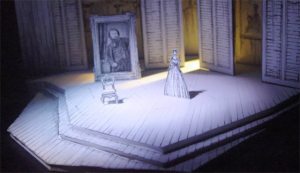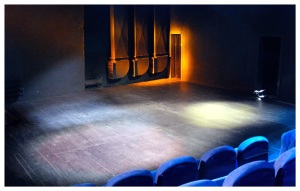The Functions of Scenic Design

Scenic design serves many functions. It defines the performance space by establishing distinctions between onstage and offstage. Through the use of flats, drapes, platforms, floor treatments, or other means, designers delineate the areas that will be used for the dramatic action. Designers may employ a great deal of masking so that persons or objects outside a clearly marked area cannot be seen by the audience; or they may use virtually no masking and thereby acknowledge that the place of the action is a stage that continues into the wings as far as the audience can see. In arena and thrust theatres, the layout of audience seating itself may outline the acting space. In a variable space, acting space and audience space may be intermingled.

Scenic design creates a floor plan that provides multiple opportunities for movement, composition, character interaction, and stage business. The location of exits and entrances, the placement (or absence) of furniture, the presence or absence of steps, levels, and platforms—all the elements of the setting and their arrangement—are among the greatest influences on blocking, visualization, and movement. A setting can be organized in many different ways; arranging it to maximum advantage for a specific production requires careful and cooperative planning by designer and director.
 Scenic design visually characterizes the acting space. Just how it does so depends on the production concept. If the concept demands that locales be represented realistically, the designer will probably select architectural details, furniture, and decorations that clearly indicate a specific period and locale. For example, the designer might create a setting fix A Doll’s House that suggests a room in a Norwegian house around 1880. Another production concept might demand fragmentary settings with only enough pieces to establish the general character of the locale. Another might rely largely on visual motifs and theatrical conventions from the era when the play was written. A setting for Tartuffe, for example, might use decorative motifs and a wing-and-drop setting reflecting the age of Louis XIV. Or, as has become increasingly common, the concept may demand that the time and place of the action be altered (such as Hamlet being translated to an American Mafia context).
Scenic design visually characterizes the acting space. Just how it does so depends on the production concept. If the concept demands that locales be represented realistically, the designer will probably select architectural details, furniture, and decorations that clearly indicate a specific period and locale. For example, the designer might create a setting fix A Doll’s House that suggests a room in a Norwegian house around 1880. Another production concept might demand fragmentary settings with only enough pieces to establish the general character of the locale. Another might rely largely on visual motifs and theatrical conventions from the era when the play was written. A setting for Tartuffe, for example, might use decorative motifs and a wing-and-drop setting reflecting the age of Louis XIV. Or, as has become increasingly common, the concept may demand that the time and place of the action be altered (such as Hamlet being translated to an American Mafia context).
 Another way of characterizing the space is to treat it as flexible and nonspecific, a common practice for plays with actions divided into many scenes and set in many places, as is typical in most of Shakespeare’s plays. To represent each place realistically would require a large number of sets as wet1 as a great deal of time to change them, thereby interrupting the continuity, rhythm, and flow of the action. On the other hand, to play all of the scenes on the flat floor of an undecorated stage might become monotonous. A common solution is an arrangement of platforms, steps, and ramps that breaks up the stage space, that provides several acting areas that can be localized as needed through the addition of a few well-chosen properties, pieces of furniture, banners, images projected on screens, or through other means.
Another way of characterizing the space is to treat it as flexible and nonspecific, a common practice for plays with actions divided into many scenes and set in many places, as is typical in most of Shakespeare’s plays. To represent each place realistically would require a large number of sets as wet1 as a great deal of time to change them, thereby interrupting the continuity, rhythm, and flow of the action. On the other hand, to play all of the scenes on the flat floor of an undecorated stage might become monotonous. A common solution is an arrangement of platforms, steps, and ramps that breaks up the stage space, that provides several acting areas that can be localized as needed through the addition of a few well-chosen properties, pieces of furniture, banners, images projected on screens, or through other means.
How the scenic design characterizes the performance space may make a strong interpretational statement. The setting for Beckett’s Happy Days visually sums up the human condition as depicted in the play: an individual isolated, trapped, forced to make the best of her lot. For a play about war, the game of chess has been used as a metaphor~ with the stage floor laid out in black and white squares and the characters costumed to suggest chess pieces. The settings for The Hairy Ape” incorporate images of human beings caged and dehumanized.

Scenic design creates mood and atmosphere. Robert Edmond Jones’s setting for Macbeth creates a powerful mood of foreboding as the masks of the witches brood over the stage and the Gothic arch’s lean ever more precariously. (See the illustration on page 193.) On the other hand, Ezio Frigerio’s settings for The Servant of Two Masters (see the following page) create a sense of carefree improvisation through details painted on cloths (with slits flit entrances) suspended like shower curtains on visible rods.
Scenic design is only one part of a Total Design, which includes costumes, lighting, acting, and all the other elements of a production. It should evolve in consultation with those responsible for the other pans of the whole. It is not, as a painting is, complete in itself it cannot be judged entirely by appearance, because it should not only look appropriate, but also function appropriately.

http://classnotes47.tripod.com/theater/theatertest3a.htm
Leave a comment
No comments yet.

Leave a comment